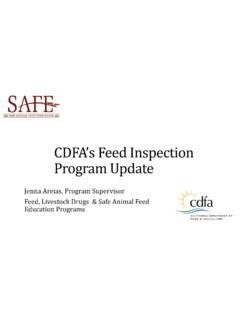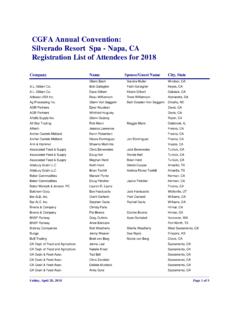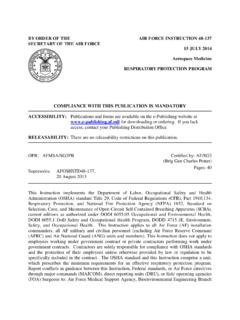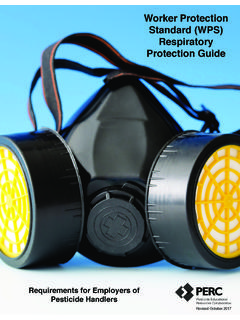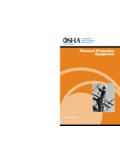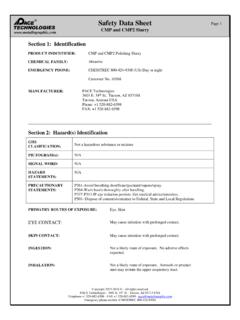Transcription of Personal Protective Equipment (PPE) and …
1 Personal Protective Equipment (PPE) and respiratory protection Personal Protective Equipment , PPE Regulated by OSHA Requires employers to supply PPE and have workers use the Equipment to protect them from of PPE Foot protection Hard toe shoes & Rubber boots, Eye and face protection Safety glasses, Goggles, face shields, Welding glasses. Respirators Dust Masks, full and half face mask respirators with filters or canisters, Self Contained Breathing Apparatus, powered air respirators. Hand protection Special gloves of a wide variety to protect against physical nicks, cuts, bruises or , friction , Chemical protection , electrical, Fall ProtectionRespiratory ProtectionInspection and Maintenance PPE needs to be properly maintained and in safe condition. Respirators must be inspected Monthly. Workers must be trained in its use. New Emphasis by OSHA on this.
2 We are required to do an assessment of plant areas to document what needs to be worn and under what Hazard Assessment Areas of the facility are to be evaluated for the presence of hazards associated with foot, head, eye, face, hand, ears, respiratory and skin injury possibility. Grain elevator facilities a. Head house and other grain handling areas b. Grain receiving and shipping c. Rail operations d. General grounds e. Barge loading/unloading f. Maintenance shops g. Grain storage. h. Electrical control and MCC Hazard AssessmentTraining RequirementsTraining shall address: when PPE is necessary; what type is necessary; how to wear it properly; limitations of selected PPE; it s proper care, maintenance, it s useful life and disposalWhen to do training Initially if PPE Changes If changes in workplace If workers shows they did not retain training.
3 All training is to be certified (written record)PPE Training Certification 29 CFR ) Permissible Practiceb) Definitionsc) respiratory protection Programd) Selection of Respirators e) Medical Evaluationf) Fit Testingg) Use of Respiratorsh) Maintenance & Care of RespiratorsRespiratory protection Standardi) Breathing Air Quality & Usej) Identification of Filters, Cartridges& Canistersk) Training & Informationl) Program Evaluationm) Recordkeepingn) Dates of Compliance respiratory protection Standard Appendices AFit testing Procedures B 1 User Seal Check Procedures B 2 Respirator Cleaning Procedures CMedical Evaluation Questionnaire DInformation for Employees usingRespirators VoluntarilyRespiratory protection StandardThis section applies to: General Industry(part 1910) Shipyards(part 1915) Marine Terminals(part 1917) Longshoring(part 1918) Construction(part 1926) respiratory protection StandardPermissible (a)(1)In the control of those occupationaldiseases caused by breathing aircontaminated with harmful primary objective shall be to prevent atmospheric protection StandardPermissible PracticeEngineeringPermissible PracticeWhere engineering control measures are not feasible, or are being instituted,appropriate respirators must be (a)(2)Respirators shall be provided by the employer when such Equipment is necessary to protect the health of the PracticePotential respiratory HazardsSUBSTANCE Grain Dust -Barley, Oats WheatGrain Dust -PNOR (Corn, Soybean)
4 PhosphineAmmoniaChlorineOSHA PEL10 mg/m315 ppm50 ppm1 ppm What respiratory hazards are you concerned with?Selection of (d)(1)(iii)The employer shall identify and evaluate the respiratory hazard(s) in the include a reasonable estimate of employee & Evaluate respiratory HazardsSelection of RespiratorsComposite of Data -Mathematical Approaches -How do you make a Reasonable Estimates of employee exposure?Monitoring - Employer requires respirator is required whenever: respiratory protection Program Concentration > PEL,Must establish and implement awritten respirator program withworksite-specific respirators: necessary to protect the health of the employee; or required by the employer? Does the employer permit voluntary use of respirators?Does the only use of respirators involve the voluntary use of filtering facepieces (dust mask)?
5 YESNOSTOPNOYES Respirator itself does notcreate a hazard, Provide copy of Appendix D, No Respirator Programrequired. Respirator itself does not createa hazard, Provide copy of Appendix D, Medical approved to use therespirator Program Requirement Clarification Required Use = Full Program Voluntary Use = Appendix D (Exception -When traditional style respirators are used a Medical Evaluation is required). General (c)(3)The employer shall designatea program administrator who isqualified by appropriate trainingor experience to oversee Program Administrator Develop and implement worksite specific procedures and elements for required respirator protection (c)(1)Selection of (d)(3)Select respirators that are adequate to protectthe health and to ensure compliance with all other OSHA standards. Routine;Reasonably foreseeableemergency situations.
6 Selection of (d)(1)(ii)ONLY USECERTIFIED RESPIRATORSS election of (d)(3)The respirator selected shallbe appropriate for the chemicalstate and physical form of thecontaminant . Selection of (d)(3)(iii)(b)(2)Employer must implement a change out schedule for canisters and before the end of its service or ScheduleSelection of (d)(1)(iii)Identify & Evaluate respiratory HazardsIf you cannot identify or reasonably estimate the employee the atmosphereto be IDLH. Selection of RespiratorsDefinition Immediately Dangerous to Life and Health (IDLH)..is an atmosphere that poses an immediate threat to life, would cause irreversible adverse health effects, or would impair an individual s ability to escape from a dangerous of Respirators Atmosphere at or above the NOISH IDLH level. Oxygen deficient 30minSAR withAuxiliary SCBAUse of Respirators One person or more, trained, equipped & located outside the IDLH area ready to provide effective rescue, Communication, Notify / additional assistance if rescue is needed, Retrieval Equipment , SCBA or SA with escape SCBA.
7 When Entering IDLH AtmospheresUse of (g) The standard requires the employer to establish and implement procedures for the proper use of of Respirators Prohibited Conditions: Removing the respirator in a hazardous environment Facial face/facepiece Glasses or goggles Any condition that interferes with the face to facepiece seal or valve functionFace piece seal protection The employer shall provide a medical evaluation to determinethe employee s ability to use a respirator, before the employeeis fit tested or required to use the respirator in the workplace. Medical (e) respiratory Medical EvaluationJOBUSERRESPIRATORPROGRAMM edicalRecommendationVariables Type of respirator worn Job tasks Workplace conditions Medical status of the employeePhysiological burden associated withrespirator use varies with:Job/Workplace Conditions Nature of exposure hazard(s) Duration of respirator use Frequency of respirator use Level of physical work effort Use of heavy and/or impervious Protective clothing Temperature and humidity extremes Scope of Examination Use the Medical Evaluation Questionnaire found in Appendix C Identify a physician or other licensed health care professional to perform evaluationsAdministration Of Questionnaire Examinations Confidentiality During employee s normal working hours In manner that ensures understanding Including opportunity for employee to discuss questionnaire and examination resultsSupplemental Information for Health Care Professional Written respiratory protection Program, Selected respirator(s) Substance(s) Copy of 29 CFR RecommendationFIT (f)
8 All employees required to use tight fitting negative or positive pressure respirators must be fit tested. FIT (f)Tight-Fitting RespiratorsHalf MaskFiltering FacepieceUse of RespiratorsAppendix B 1 User Seal CheckEmployees must perform a user seal checkeach time they put on a tight fitting Te s t i n g Requirements Employees using tight fitting respirators must pass an appropriate qualitative (QLFT) or quantitative (QNFT) fit RespiratorsHalf MaskFull FacepieceHoodHelmetFacepieceLoose Fitting RespiratorsFit Te s t i n g Qualitative fit testing methods are subjective in nature and rely onthe judgment of the test subject. A proper fit is determined if the respirator wearer does not detect the taste of the test solution in an controlled Fit Te s t i n gQualitative Fit Te s t i n g (QLFT)Appendix A Four accepted protocols (OSHA) Bitrex(denatonium benzoate) Saccharin Isoamyl acetate (banana oil) Irritant smoke (stannic chloride)Fit Te s t i n g Quantitative fit testing methods rely on objective data to determine a proper fit.
9 As a result, the test produces quantifiable results. For tight fitting PARPs, SAR and SCBA must fit tested in the negative pressure (f)Fit Te s t i n gWhat type of fit testmust done when usingthis type of respirator?QLFT or QNFT ?Acceptable Fit testing MethodsType of RespiratorQLFTQNFTHalf-face, Negative PressureAPR (Up to 10X PEL)Ye sYe sFull-face, Negative PressureAPR (Up to 10X PEL)Full-face, Negative PressureAPR (Over 10X PEL)Ye sYe sYe sNoPhosphine PEL is ppmQLFT (up to 10 X PEL) - ppmQNFT (over 10 X PEL) - 15 ppm Acceptable Fit testing MethodsFit Te s t i n g Frequency Prior to initial use Annually thereafter Whenever a different facepiece is to be used Whenever changes affecting respirator fit are observed Whenever employee determines fit is unacceptableMaintenance & Care of Respirators (h)Maintenance & Care of Respirators Cleaning / Disinfecting Respirators must be clean and maintained in a sanitary condition.
10 According to Appendix B 2 Protected from damage Emergency Respirators: Stored in compartments or covers marked as Emergency Respirators According to the ManufacturerMaintenance & Care of RespiratorsProperly store all respirators: Insure Respirators are Inspected: Respirators used routinely: Before each Use and during cleaning Emergency use respirators: Before and after each use. At least monthly According to manufacturer & Care of Respirators Certification of Inspections (Emergency Use Respirators): Documentation Tag attached to the storage compartment or other record. Maintenance & Care of (k) TRAININGT raining and InformationGeneral Requirements Training must be provided to all employees who are required to wear a respirator. Must be:Comprehensive,Understandable, Why a respirator is necessary What are the limitations and capabilities of the respirator How to use the respirator effectively in emergency situations, including malfunction How to inspect, don/doff, use and check the seals of the respiratorTraining and InformationEmployees must be able to demonstrateknowledge of: The procedures for respirator maintenance and storage How to recognize medical signs & symptoms that may limit the effective use of the respirator General requirements of and InformationEmployees must be able to demonstrateknowledge of.
